Today’s tutorials comes to you from one of my favorite soapmakers, Kenna from Modern Soapmaking. Her soaps always have unique designs, ingredients and colors. She is consistently pushing the soaping envelope. This recipe is particularly intriguing because it breaks a few conventional soaping “rules.”

There are a lot of “rules” of soap making that get spread around like wildfire, and for the most part, they are true…
But not always! 100% coconut oil soap defies not one, not two, but THREE of the soapmaking rules I’ve heard from other soap makers in the past:
- Single oil soaps do not perform as well as synergistic formulas with multiple oils.
- Using over 30-40% coconut oil in a soap recipe is too drying for the skin.
- Superfatting above 10% will leave too many free oils and cause the soap to spoil or develop DOS.
What’s the magic soap recipe?
I hit the workshop to make a 100% coconut oil soap with a 20% superfat, an amazingly luxurious formula that is one of my all time favorites. Plus, I power-packed it with goodies, too, like coconut flour and aloe vera juice, and pulled out a mantra swirl with an embed.
Coconut oil has great shelf life and stability, so it’s the perfect oil for extreme superfatting. This coconut oil soap formula results in a rock hard bar, with luscious lather, without drying the skin out. Ready to give it a shot? Let’s do this thing.
Recipe
36 oz Coconut Oil
5.18 oz Lye (Sodium Hydroxide)
10.53 oz chilled Aloe Vera Liquid
1.5 oz Fragrance Oil (optional)
2 tsp Coconut Flour (optional)
Soap balls for embeds (optional)
2 teaspoons of Mica (optional)
Silicone Loaf Mold
a 5 quart bucket
a 2-cup measuring cup with spout
three 4-cup measuring cups with spouts
a piece of cardboard cut to fit in the mold
Bamboo Skewer
Spatula
Stick Blender
Get Down to Business:
This tutorial assumes you are an experienced soap maker. If you’ve never made Cold Process soap before, stop here! I highly recommend checking out our FREE four part SoapQueen.tv series on Cold Process Soapmaking, especially the episode on lye safety. And if you’d rather do some reading, Bramble Berry carries a wide range of books on the topic, including my newest book, Soap Crafting. You can also checkout the digital downloads for that instant gratification factor.
ONE: Prepare your mold by lining it, if necessary. Cut out a piece of cardboard that fits length and height-wise into your mold snugly. Place the piece of cardboard down the center of the mold to divide the mold in half lengthwise.
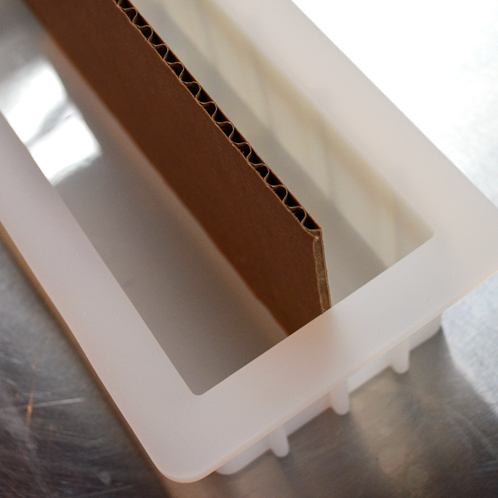
TWO: Prepare your lye solution by slowly pouring the sodium hydroxide into the chilled aloe vera juice, stirring until the lye has dissolved. The aloe vera will turn a mustard yellow color, like pictured to the right. Allow to cool.
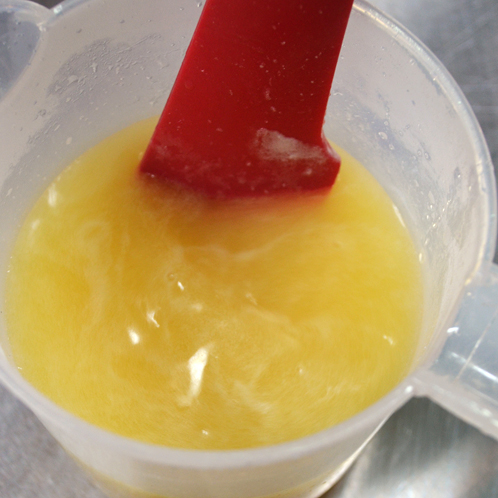
THREE: Heat your coconut oil to about 120° to 130° F. You want to soap this formula hot (I usually soap at room temperature), soaping coconut oil at too low of a temperature will increase your chances of false trace. I add my fragrance to my oils before my lye solution so I don’t forget it later on.

FOUR: Prepare two containers with mica for coloring the soap halves. I use 1 tsp of mica and 1 tsp of coconut flour per container, with 2 tsp of base oils for each container from my main soaping pot. Using a frother, I thoroughly mix the mica and coconut flour with the oils.
FIVE: Combine half of your lye solution with your coconut oil, and stick blend thoroughly. Add the remaining half of your lye solution, and stick blend only until emulsified. I always refrain from over-mixing – bringing your soap to an emulsion first, and then adding anything extra allows you more time to focus on what is happening with the soap.
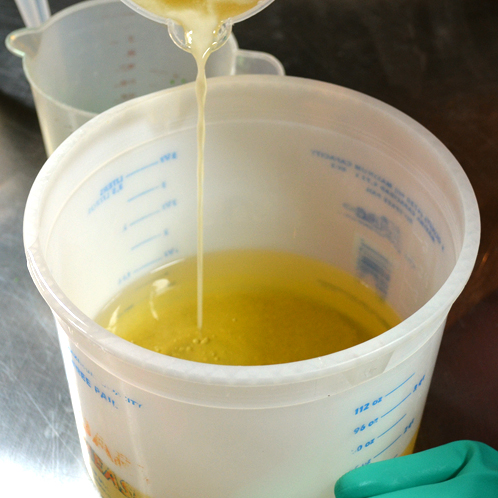
SIX: Split the batch of coconut oil soap between your two containers and thoroughly mix with a spatula. If you are still at a barely emulsified or very light trace, bring the coconut oil soap in each container to a medium trace using your stick blender. A medium trace is my favorite pour viscosity for a mantra.
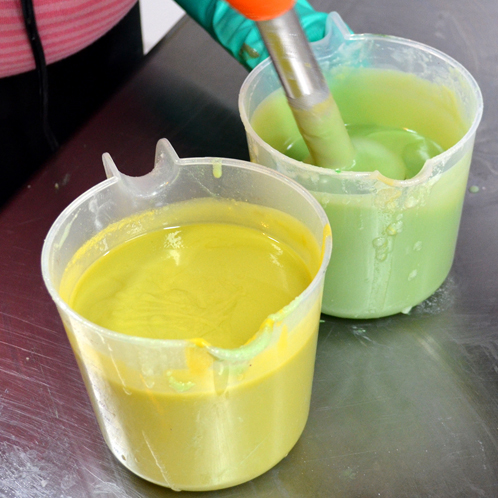
SEVEN: When your mica and coconut flour are thoroughly mixed into each part, begin your pour. I pour both halves at the same time so that there is equal force and weight on each side of the cardboard divider. You can also use two more pieces of cardboard on the ends of your mold with notches cutout to hold the divider in place.
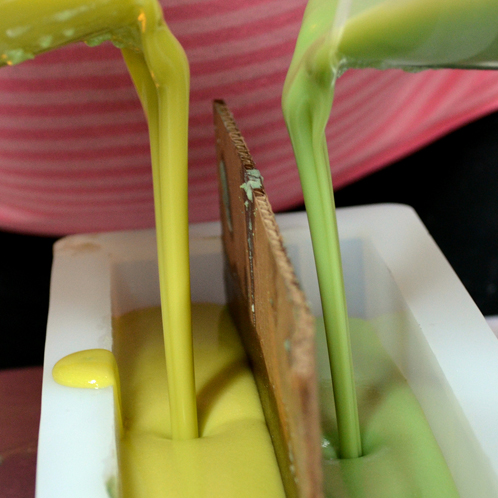
EIGHT: Once both halves are poured, carefully and slowly pull your cardboard divider straight up out of the mold. If you are embedding soap balls, use a bamboo skewer to push them down into the soap. Or place them mid-way through pouring.
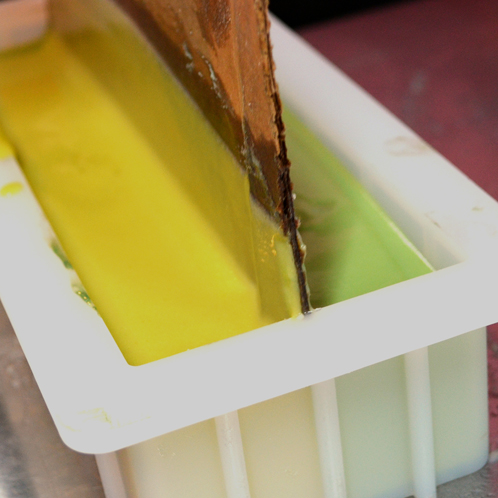
NINE: Using a bamboo skewer (or chopstick, or your personal weapon of choice!), swirl the mantra. Pushing the skewer down into the mold all the way to the bottom will swirl both sides of your soap. If you only put the end of the skewer into the soap, you can swirl just the top, leaving a crisp line between the two halves in the bars.
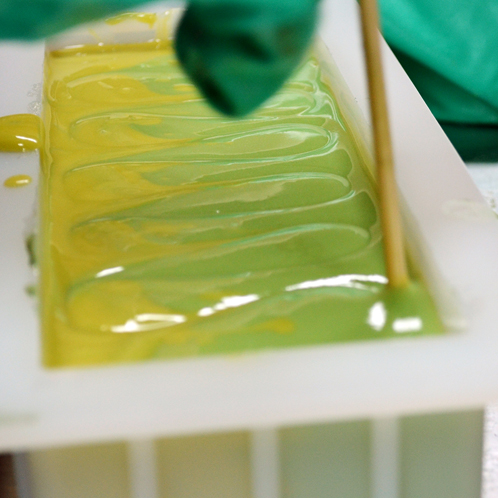
TEN: Put the pretty soap to sleep. I do not insulate coconut oil soap, but you can if you want to (same with CPOPing.) Unmold and cut the coconut oil soap as soon as it has hardened up. It sets up real hard, and real quick! You’ll want to clean up the bars of coconut oil soap straight out of the mold, such as beveling or planing – this soap will be a brick in 24 hours flat. The lather is really creamy and luscious straight out of the mold, and just gets better and better as it ages.
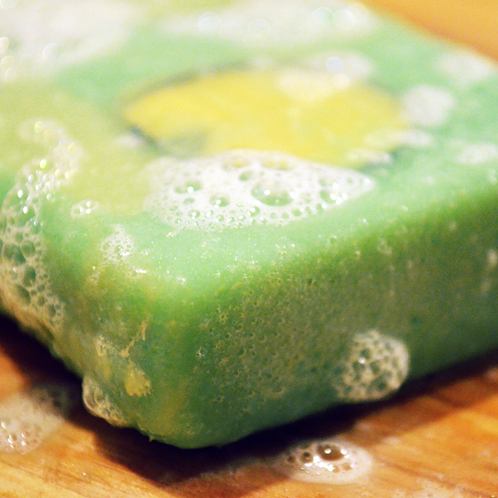

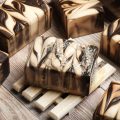
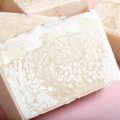

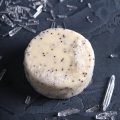
I made this soap as directed and actually found the end product to be a little drying, I was really hoping to love this soap. After using it in the shower I felt like I had a powdery dryness all over my body. I really loved the amount of lather and how the slip of the soap while I was using it. The only thing I did differently from the recipe listed above was I scented it with 4 different citrus essential oils, Lemon, orange, lime and grapefruit. I did not use more than the 1.5 ounces called for in the formula. Could that have been the problem?
Hi Stephanie!
Oh no, I’m sorry to hear that! The essential oils should be just fine, especially because you used the recommended amount. 🙂
Everybody’s skin is a little bit different. While this recipe may work for some, it may be drying for others. If you’re looking for a moisturizing and soothing recipe, you may like this Buttermilk Baby Bastile Bar: http://www.soapqueen.com/bath-and-body-tutorials/cold-process-soap/buttermilk-bastille-baby-bar-on-soap-queen-tv/
The Once Upon a Dream Cold Process Recipe is very moisturizing as well: http://www.soapqueen.com/bath-and-body-tutorials/cold-process-soap/once-upon-a-dream-cold-process-tutorial/
-Kelsey with Bramble Berry
Do you have any suggestions on what I can do with this batch? I was thinking laundry soap, but maybe too many free oils. Any other thoughts? is there a way to rebatch this to be more moisturizing?
Hi Stephanie!
You can rebatch the soap if you like! Typically, adding extra oil to rebatch can make it a bit oily or greasy. In this case, that may be helpful though. We recommend about 1 teaspoon per pound of soap. 🙂
You can also rebatch the coconut soap and add an equal amount of extra soft and moisturizing soap to it, like castile soap. That can add a bit more moisture to the bar.
How to Make Rebatch Soap: http://www.soapqueen.com/bath-and-body-tutorials/cold-process-soap/soap-queen-tv-presents-how-to-make-rebatch-soap-2/
Castile Rebatch: https://www.brambleberry.com/Grated-Rebatch-Soap-Base-Castile-P5233.aspx
-Kelsey with Bramble Berry
Do you have any suggestions on what I can do with this batch of soap, i’d hate to waste it. Would this work for laundry soap or is there too much free fat from the 20% superfat? can I rebatch it some way to make it more moisturizing?
Hi Stephanie!
You can rebatch the soap to try and make it more moisturizing! I would suggest rebatching the soap with equal parts of a very moisturizing soap, like castile soap, to try and soften the bar up a bit. 🙂
How to Make Rebatch Soap: http://www.soapqueen.com/bath-and-body-tutorials/cold-process-soap/soap-queen-tv-presents-how-to-make-rebatch-soap-2/
Castile Rebatch: https://www.brambleberry.com/Grated-Rebatch-Soap-Base-Castile-P5233.aspx
I wouldn’t recommend using the soap for laundry soap. With such a high superfat, it likely won’t clean clothes very well. Rebatching is worth a try in this case!
-Kelsey with Bramble Berry
I apologize if this question was already answered.
I make very small batches of soap (smallest being 8 oz of oil up to 16 oz oil) because I like variety too much and I have very little space to store and cure soaps. Since the lye calculator doesn’t go higher than 10% superfat, how do I safely scale down this recipe to fit my molds?
Thanks!
Hi there!
You can calculate that SAP value yourself if you like! Learn more about calculating that here: http://www.soapqueen.com/bath-and-body-tutorials/tips-and-tricks/free-beginners-guide-to-soapmaking-common-soapmaking-oils/
If you’re anything like me and not a big fan of math, there are other calculators that have higher superfat options. To find those, you can type “lye calculator” into your search engine. 🙂
-Kelsey with Bramble Berry
I made this soap Yesterday. 100% coconut oil superfated at 20%. I combined oils at around 120 degrees and all went just fine. I did a three tier effect by adding stabilizer to my scent at two different levels and poured dividing soaping two measuring cups and my bowl so I had three levels of color because my scent is coconut vanilla, I know it turns soap brown. in short I have three layers ,brown, beige and top is white because i added titanium dioxide to one layer…looks like a dessert . My question is- Is your soap oily?? I cut my soap last night and this morning it is oily and is this due to the 20% superfat??
Hi Kathy!
That sounds like a lovely bar! Coconut vanilla smells so yummy. 🙂
This soap does have a high superfat content, so it may feel a bit slick or oily. However, the bars should be fairly firm, and there shouldn’t be any oil seeping out. Are you noticing beads of oil on your bars?
Also, while Vanilla Color Stabilizer works great in melt and pour, we’ve found the results are inconsistent in cold process. Eventually, that soap will turn brown. It will still look beautiful though!
Vanilla Color Stabilizer: https://www.brambleberry.com/Vanilla-Color-Stabilizer-P4156.aspx
-Kelsey with Bramble Berry
Hi all, I made a really lovely luxurious soap using pure aloe vera, coconut oil and oatmeal, nothing else! I buy the aloe vera in a block from a lady that has a country house and she mixes it with the lye, so I just go and buy a huge block from her. I very stupidly go very sunburnt the other day and was looking on the internet for fast relief from the pain, lots of sites said oats, aloe vera and coconut (pure, unrefined) oil and I suddenly remembered that I had lots of my homemade soap left with those exact ingredients. I had a luke warm shower (even that was painful) then lathered up (as much as it would lather up) my soap, covered myself with it and left it on for about 5 mins. After whilst still wet I put coco oil all over the sunburn, the slightest touch was agony, but within 5 minutes there was very noticable, and very welcome lessening of itching and pain, 1 hour later the tightness had gone and now, 2 hours later there is hardly any pain and the redness has definately gone down. I shall ensure that I don´t get burnt again, but at least now I know the best relief is my lovely homemade soap!!! Shall most definately be making more and trying out new ones!!
Hi Teresa!
That sounds like an awesome recipe! I have fair skin and I always keep aloe soap and lotion on hand. Glad to hear yours made your sunburn a little more bearable! 🙂
-Kelsey with Bramble Berry
Yes, I made a 1 pound version w/o the aloe vera. Please add higher % of superfatting on the lye calculator 🙂 Had to break out the calculator to figure out my lye, whew. I used a 15% super fat with lavender and rosemary EO. I plan to try the bar out as a shampoo bar. Fingers crossed!
Hi Jenner!
Thanks so much for your suggestion! I’ll pass that along to our IT team. 🙂
Also, lavender and rosemary is a lovely combination. I bet your bars smell amazing!
-Kelsey with Bramble Berry
Would I be able to change aloe vera liquid for aloe vera gel?
Hi Natasha!
We didn’t test this recipe with aloe vera gel, so I’m not 100% sure. Aloe vera gel is thicker, so it may change the consistency of the soap. I would recommend making a small test batch to see how the gel works with this recipe. 🙂
-Kelsey with Bramble Berry
I have made 100% coconut oil soap in the past and I absolutely love the feel of it! So creamy!
I am planning on making some lavender soap this week using all coconut oil. I was going to infuse alkanet root into the coconut oil, but I wasn’t sure how much to use. I have only ever infused in olive oil so I wasn’t sure if there would be any difference. Brambleberry recommends infusing 1 Tbls of alkanet per 4 oz. of oil and then using 2 Tbls. of this infusion in a 3 lb. batch. Should I soap this infused oil as usual or add it in at the end?
Hi Rebecca!
Sounds like a fun project! You could do either actually! If you’d like your entire batch colored with alkanet, you could soap with the infused oil as usual. Or, if you’d like only a portion of the bar colors with alkanet, you could add the infused oils at trace like you would a colorant. Either way would work great! Let me know if you have any more questions 🙂
-Amanda with Bramble Berry
Please consider changing your lye calculator to allow for up to 20% super fat!! 🙂
Hi Michelle!
I’d be happy to pass along your suggestion :).
-Amanda with Bramble Berry
i’m going to try this recipe today and i’m very excited! off to the store in a sec for some Aloe Vera juice. I suggest maybe adding that 20% superfat opt to the lye calculator. I want to make a smaller batch. can’t wait to see how it comes out
So glad you’re going to give this recipe a try Chris! I will pass along your suggestion 🙂
-Amanda with Bramble Berry
Made this yesterday. Resized this recipe for a 12oz batch and I’m pretty much in love with 100/20 coconut oil soap!!! I made it in a crock pot, and it sure didn’t take long to cook. I was prepared for this and blended it to a thinner trace than I usually do. Ended up with a bright white bar, veined it with a little charcoal, and it looks kinda like chunks of marble. It’s currently curing in my garage, but that might be for no reason because it’s AMAZINGLY HARD! As usual, I scraped out the last bits of soap from the pot that cooled too quick to go into the mold and rolled it up into a ball a little bigger than a Whopper candy. The lather is amazing and it took fragrance like a champ. I suppose the top looks a little rough, but it’s smoother than my previous HP experiments have been, now that I know a few tricks. Haven’t gotten to use the actual bars yet, but the thin end piece I cut off didn’t seem to have any graininess or anything wrong with it. Just smooth lather!
Thanks for this recipe! It’s a huge inspiration and it just became my staple.
Hi Katenik!
That’s awesome! I’m so glad this recipe worked out well for you. We love the big fluffy bubbles and bright white color. I bet it looks great with the charcoal vein. 🙂
-Kelsey with Bramble Berry
Hello!
Just trying to troubleshoot my issue with my cracked soap! I noticed everywhere people are saying that the cause is from over-heating, but I just wanted to see exactly what my problem was here.
So here is my recipe and how I did it below as detailed as possible:
I ran this through the lye calculator first (I used OZ, although your calc says in the thousandth, mine is in the tenths only so I just guessed as exact as I could)
Coconut oil 76% – 16oz
Lye – 2.791 oz (rounded to 7.8)
Water – 5.28 oz (rounded to 5.3)
I remember the temp of my oils at 28 Celsius and my lye water down to 22 Celsius when I mixed the two. It came to trace quite fast in my new handy dandy 2 speed Kitchen Aid stick blender (Speed 2 for probably less than a minute while stirring constantly and blending) it was at a nice trace, not too thick and not too thin, either. I remember it looked as though it had riced in the beginning but blended beautifully after.
Was it the oils that were too hot? I’m guessing it was the temperature difference.
Anyways, added about 50-55 drops of lemongrass essential oil which I picked up from my local soap-making supplies store (Soap&More) and also used about 20-30 drops of organic peppermint oil, and mixed it in with a spoon thoroughly until I couldn’t see anymore discoloration.
Anyways, I poured it into my parchment lined wooden soap mold and just left it sitting there in my room temperature(17C) for about an hour before I checked on it again. I noticed the large crack then. Definitely was a lot of heat going on inside as the bottom of my mold was pretty warm and hovering my hand over the top I could feel some heat coming off it as well, not a big deal for me. Now it’s super hard after about 6 hours, but there’s a little hardish slightly lesser white color residue on the top in which I can’t figure out… Is it soap that exploded over? Did the lye separate? (I can’t imagine it’s that because it mixed so well in together)
Can I do the zap test immediately? Can I cut it up it right now?
Sorry about the large story, it’s my third time making a batch of soap 🙂
-Danielle
oops I meant 2.8 Lye!!!
Update… cut the soap. Soap was hard as rock, almost crumbly! No discoloration besides the top. Could bubbles because I forgot to bang it against the table after pouring. Hope this helps 🙂
Hi Danielle!
I’m wondering if it’s soda ash. Soda ash forms when unsaponified lye reacts with naturally occurring carbon dioxide in the air. Soda ash is a harmless. The great news is you can also get rid of soda ash!
To remove it, you can use a nylon to scrub it off the top. You can learn more about soda ash and how to prevent it in this blog post: http://www.soapqueen.com/bath-and-body-tutorials/tips-and-tricks/explaining-and-preventing-soda-ash/
-Kelsey with Bramble Berry
It was only discolored as it was more of an orangy color, not ashy color, which I’ve had before. Could it still be soda ash?
Hi Danielle!
I think it may help if I see a picture of it! That way I can take a look and have a better idea of what it looks like. Can you send one to [email protected]? Thanks so much. 🙂
-Kelsey with Bramble Berry
Hi Danielle
If i may offer a bit of friendly advice 🙂
Next time you try this recipe soap at 100 degrees F. I have been making 100% coconut oil soap pretty much exclusively for a while now and have never had any problems when using this temp. The fact that you said there was a substantial amount of heat radiating isnt good, at 100F i can touch the mix with (gloved) hands without discomfort and i dont need to worry about the table i place my molds. 🙂 Also dont underestimate the speed at which it hardens, for this reason i use cavity molds (its just simpler) you may need to check back every 30 minutes to ensure the block doesn’t go too far and cutting become difficult.
Also you may want to add the EO before blending with your mixer as i find there’s just not enough time to blend the EO in after trace as the soap will start to harden and give you a lumpy top 🙁
Definitely try 100% coconut soap again, its brilliant especially if you love big fluffy bubbles like me (its the child coming out of me haha)
Have a lovely day 🙂
Hi Carmen!
Thanks so much for your awesome tips! I think soaping at 100F is a great idea. 🙂
-Kelsey with Bramble Berry
tried it last month. super hard, super bubbly, not at all drying… love it! (i added instant coffee to the top half before pouring) only 1 cosmetic problem – soap developed surface cracks after a couple of weeks of use… i do vaguely understand the physics of this, but anyone have any suggestions for getting rid of them?
Hi Sheetal!
So glad you like the recipe! Cracks in the soap are typically caused by overheating. What temperature did you soap at, and how did you store your soap? When did you unmold and cut it? Let me know and I’ll help you troubleshoot. 🙂
-Kelsey with Bramble Berry
I tried this recipe today. I’m still pretty beginner with soap making but I believe I followed everything to a T except I only made it one color, I used the cucumber and green tea fragrance oil from brambleberry and I got a soap volcano about a minute after pouring it. What could I have done wrong? I used the same mold and everything else I believe was the same. Now my soap is really ugly (I scooped up what I could and just sort of smashed it back down). Once it sets can I cut it and then sort of do a melt and pour deal with it? Melt it down again then try pouring it into the mold? Or will this disaster even be soap? Thanks!
Hi Angie!
Oh no! Can you tell me a little bit more about your process, including what temperature you soaped at and how you stored your soap after it was in the mold?
Cold process soap is different than melt and pour soap. Cold process soap will not turn into liquid in the microwave and cant get a crust on top. However, you can use a rebatching technique on this soap. That involves grating the soap and putting it over gentle heat like a double boiler until the soap looks like mashed potatoes. I’ll include a link on how to do that. 🙂
-Kelsey with Bramble Berry
Soap Queen TV Presents How to Make Rebatch Soap: http://www.soapqueen.com/bath-and-body-tutorials/cold-process-soap/soap-queen-tv-presents-how-to-make-rebatch-soap-2/
Thanks for the reply! I soaped at right at 130 degrees and I didn’t have a chance to move my mold off of the counter before it started erupting. I do believe I brought it to too much of a trace (heavy trace?), it definitely did not pour as smoothly as your pictures. But I believe everything was pretty muh by directions
Mixed lye and aloe
Melted oils
Once oils reached temp I added fragrance then mixed the mica with a couple of tbsp of my oils
I blended my lye/water with oils just until mixed then added the mica blend and blended to trace (like I said I think maybe too much of a trace)
Then poured it into the silicone mold. It looked very pretty but the top got hard and set almost immediately then the top cracked and the inside just poured out of it. It erupted for about a minute, I scooped it back and smashed it back into the mold. It looked really ugly but it all set very nicely and i cut it yesterday and it actually has a pretty sort of artisan look to it. Not as bad as I thought it would be. I tried using just a shaving that broke off and it actually has a really wonderful lather so it seems it did make great soap but i would prefer to avoid the volcano next time :). I’m thinking my temp, was too hot and maybe I need to go with more of a medium to light trace?
Hi Angie!
Thanks so much for that information! Also, I’m glad that soap turned out well. 🙂
I have a few more questions if you don’t mind! How long did you stick blend for? Was your aloe vera liquid chilled?
-Kelsey with Bramble Berry
I didn’t blend for long, less than 3-4 minutes I would say. The aloe vera was chilled but I would say the temperature of a cool drink, no where near an icy temperature if that makes sense.
Hi Angie!
Typically, volcanoes happen when the soap gets overheated. Ingredients with sugar can contribute to this, and because coconut flour is dried coconut, there may be some sugar in there. How did you store your soap, and what fragrance oil did you use?
Sorry for all the questions! Troubleshooting can be tricky. 🙂
-Kelsey with Bramble Berry
Coconut Milk Soap Volcano: http://www.soapqueen.com/bath-and-body-tutorials/cold-process-soap/coconut-milk-soap-volcano-2/
Hello
Great ideas here. I’m making several types of soap. I’m wondering if I need to be concerned about spoiling if adding oats, lemon zest, fresh mint, or bath salts. Will these soaps go bad?
Hello!
Any natural ingredients, like lemon zest and fresh mint, that you add to your soap will eventually turn brown. This is just the nature of natural products, and is something you want to take into consideration. I would recommend drying the lemon zest and mint before using it in your soap. This will make them last a little longer and prevent excess moisture from getting into your soap. 🙂
As for oatmeal, we add it to our soaps all the time! You can add full oats or ground oatmeal. I’ll include a link to a recipe that uses rolled oats below.
Also, salt bars are great for cleansing and exfoliating. They can be a little tricky to work with, as they tend to move quickly once the salt is added. I’ll include a tutorial below. 🙂
-Kelsey with Bramble Berry
Soothing Baking Soda Oatmeal Bar: http://www.soapqueen.com/bath-and-body-tutorials/cold-process-soap/soothing-oatmeal-bath-bar/
Pretty in Pink: Salty Cold Process: http://www.soapqueen.com/bath-and-body-tutorials/cold-process-soap/pretty-in-pink-salty-cold-process/
Strange question but does this soap end up smelling like coconut without the use of fragrance?
Would using Virgin Coconut Oil and the coconut flour enhance the coconut smell? I’m trying to make a soap that has a strong but natural / fresh coconut scent but I can’t seem to find a fragrance oil that smells good and/or is stable.
Hi Deanna!
Coconut oil has a more neutral smell and doesn’t smell like the delicious island coconut fragrance you may be used to! We have several great coconut fragrances you could use, including our Coconut Cream Fragrance Oil, which lasts a long time in cold process soap. 🙂
-Kelsey with Bramble Berry
Coconut Cream Fragrance Oil: https://www.brambleberry.com/Coconut-Cream-Fragrance-Oil-P5936.aspx
Papaya Coconut Fragrance Oil: https://www.brambleberry.com/Papaya-Coconut-Fragrance-Oil-P4695.aspx
We use unrefined organic coconut oil all the time. Real raw, unrefined, 76 degree coconut oil absolutely smells and tastes like coconut. If you refine it, then no, it loses all of that goodness. Plus, it’s usually refined with hexane, in case that’s a concern to you.
However, it also loses that wonderfully real coconut smell when made into soap.
Hi SwampMom!
Our coconut oil is refined so it does not have a strong coconut odor. This will change based on what kind of coconut oil you use. Thanks for your thoughtful input!
-Kelsey with Bramble Berry
Hi,
I would like to try this recipe. But I can’t find aloe juice. Can I use Aloe gel?
Thanks
Pearly
Hi Pearly!
Aloe vera gel is thicker than the liquid, so it would give you different results. I would recommend using the liquid, which we have at brambleberry.com. 🙂
-Kelsey with Bramble Berry
Aloe vera liquid: https://www.brambleberry.com/Aloe-Vera-Liquid-P3704.aspx
Hi! I’ve been soaping with this formula as well, the only difference is I’ve been using hot process with it. I absolutely love 100% coconut soap, it takes colors so beautifully.
Hi Marissa!
So glad you like it. 🙂
-Kelsey with Bramble Berry
Hi there, of course this post is really fastidious and I have learned lot of things
from it on the topic of blogging. thanks.
Hello!
So glad you’re enjoying the blog. 🙂
-Kelsey with Bramble Berry
Which type of Coconut Oil did you use? 76, 92 or Fractionated? Can you use all of these or only one type? Can you use a blend of coconut oils?
Hi Lauren!
For this recipe, 76 degree Coconut Oil was used. We only used one type of Coconut Oil, so I’m not exactly sure how blending coconut oils would work. You may want to try a small test batch. 🙂
Also, Fractionated Coconut Oil is a liquid rather than a solid oil, meaning it may take longer to harden. It also does not have the same cleansing and bubbling abilities of solid Coconut Oil.
-Kelsey with Bramble Berry
K, you guys got me all worked up! I gotta try it! I think I’m going to try a 1/2# batch just to see. A few years back I bought some silicone muffin cups that really aren’t great for muffins so I may use those. But a question…this 100% coconut oil 20% super fat seems just like Kirks Castile soap? So is it large bubbly lather or more like creamy foam?
Sorry, also if you could compare it to a value on the cleansing scale what would it be?
Hi there!
I’m glad you’re going to give this recipe a try! Coconut Oil is cleansing, but the 20% superfat helps to give this bar a softer, more gentle feel on the skin. Coconut Oil helps contribute to a fluffy lather in soap 🙂
I hope this helps!
-Amanda with Bramble Berry
Hi Kristen, thank you for the recipe.
When I tried it, my soap seized in just seconds when I add lye in the oil. I mixed the oil and lye in room temp, use SB then in about 10 seconds of mixing, it seized very fast. I can’t even scope it out 🙁
I don’t know what went wrong..
Hi Maila!
Oh no, I’m sorry to hear that happened! Did you change anything in the recipe? If you could tell me a little bit more about your methods, I would be happy to help you troubleshoot 🙂
-Amanda with Bramble Berry
Hi Amanda,
Thanks for your reply. I am using the following ingredients:
– 30oz coconut oil
– 1.5 oz shea butter
– 5.1 oz NaOH
– 10 oz water
First, I melt the shea butter, then mix it with coconut oil. I let the lye solution to cool down to room temp before mixing it to the oils. After adding lye to the oil mix, i used a stick blender to mix, but it seized in less than 2 minutes.
Thanks..
Hi Malia!
Because we haven’t tested this recipe with Shea Butter, I’m not exactly sure why it is seizing! Shea Butter and Coconut Oil are both ingredients that make a harder bar, so that may be the culprit.
I ran your recipe through the Lye Calculator, and got a recommended water amount of 11.97 oz and a lye amount of 4.5 oz. That’s a little different than yours, so that may be it!
-Kelsey with Bramble Berry
Did my coconut oil comment get to you?
Hi Shirley,
It did! Check for the response on your original comment 🙂
I want to make the 100% coconut soap oil recipe, however, I cannot tell whether we should weigh the ingredients or measured in measuring cups. Also, If I wanted to superfat part of the coconut oil with shea butter. Just a small amount. Please respond so I can start my recipe. Can the shea butter be a small part of the superfat?
Hi Shirley,
We also recommend creating recipes in weight, not volume! It’s more accurate than using cups to measure 🙂 You can read more about that here:
Weight vs. Volume: http://www.soapqueen.com/bath-and-body-tutorials/tips-and-tricks/a-guide-to-weight-vs-volume/
Superfatting with shea butter is a great idea! If you want it to be mostly coconut oil, I would recommend doing a 90% coconut oil and 10% shea butter recipe. I would choose anywhere between a 5 – 10% superfat. Our lye calculator makes it easy to do all of that!
Lye calculator: https://www.brambleberry.com/pages/Lye-Calculator.aspx
I hope that helps! Happy soaping 🙂
I, too, was considering using 90% Coconut Oil and 10% Shea Butter. Can you tell me why you would only superfat 5-10% instead of the recommended 20% for 100% Coconut Oil?
While you’re thinking of a reply to my question, let me second-guess the reason for the huge difference in SF% when changing the formula from 100% CO (SF 20%) to 90% CO & 10% Shea (SF 5-10%). Is it to avoid DOS from the added Shea content?
If that’s the concern, would adding any Tocopherol (maybe 1% of the total oils) hopefully alleviate that concern?
Or perhaps there is another reason for the huge difference in SF% when adding 10% Shea???
Thanks in advance for any ideas.
Marley
Oops!! Sorry about that duplicate original reply. Don’t know how to delete it.
Okay, I’m still guessing here and I’ve come up with another theory: Maybe I didn’t fully understand Kirsten’s original reply to Shirley Perez.
When I superfat, ALL my oils are in the same pot. I don’t hold the belief that adding an oil later in the process is going to mean that the oil added later is going to be the one that superfats your formula. It is my belief that the lye solution will attach itself to whatever oil(s) it pleases regardless of when they’re added to the pot.
Perhaps Kirsten was suggesting that Shirley reserve the Shea Butter (which makes up btwn 5-10% of the formula)and add it after trace? But still superfatting the entire formula by 20%? But then I’m further confused because Bramble Berry’s Lye Calc only goes up to 10%SF, and she recommends using it. If she really meant a total 20%SF, she would have recommended SoapCalc.
Oh well, I guess I’ll experiment both ways and let you know how it comes out. I was hoping to hear something back from someone by now to avoid that step, but I have a customer waiting for his Coconut Oil Soap and I don’t want to prolong the process.
I’ll check back from time to time to see if there is a reply here. I just don’t understand why the 20%SF would fall to 5-10%SF just because I alter my formula to include 10% Shea Butter. Thanks for letting me rack my brain in public. LOL Chime in any time.
I, too, was considering using 90% Coconut Oil and 10% Shea Butter. Can you tell me why you would only superfat 5-10% instead of the recommended 20% for 100% Coconut Oil?
I made this soap to the letter…everything i could have possibly wanted to know was covered
Its simply divine.
It is a little more cleansing than my regular recipe but I love ALL types of soap for all different moods and seasons
I feel super fresh after this one, the lather is stunning…and I want to thank you for all the wonderful information and this recipe. A winner
Hi Joy!
Oh I’m so glad you gave this recipe a try, and I’m even happier that you love it! I love having a wide range of soaps with different properties as well 🙂
-Amanda with Bramble Berry
Hi! I’m with Todd I don’t see the superfat in the recipe. Sorry if I missed it. Could you please specify what oil you used to superfat and how much? Thank you
Lori
Hi Lori –
I think you and Todd are both thinking that the superfatting oil is being added in later.
The superfat in this case is simply using less lye than is required for the recipe; also known as lye discounting.
So for example, if you were to do a 0% superfat, the recipe would be a full 6.41 ounces of lye. In this case, with the 20% superfat, it calls for over a full ounce less of lye – leaving 20% of the coconut oil unsaponified.
I hope this helps explain where the superfat is =)
Im looking at the recipe and I dont see the superfat. Am I missing something?
Hi Todd!
This recipe is superfatted at a high 20%, resulting an extremely skin loving bar of soap 🙂
-Amanda with Bramble Berry
Can you superfat at 5%, use honey or liquid glycerine at trace and still achieve a moisturising bar if using 100% Coconut Oil?
Hi LC!
The reason that this bar was superfatted at such a high amount (20%), is to ensure it is not drying to the skin. You may want to consider superfatting your soap at a higher amount to ensure your soap is not drying. Of course everybody’s skin is different, so you may find 5% to be fine 🙂
-Amanda with Bramble berry
I like the recipe and coconut oil soap can be a hit with people. So I tried the recipe but came across some problems. First, I did not have aloe vera liquid (Juice?) but had an aloe leaf, cut it and used the aloe jelly. Unfortunately, I did not have enough aloe so I had to add water. (Problem) I blended both together but had a floating of aloe fat on the top of the lye solution, but used it anyway. I did not have coconut flour so I used a tsp of mica to 1 tbp of sunflower oil for coloring. (Problem) As written in the recipe, I placed my FO into the oil then my fatty lye solution, and my soap Seized. At that point I knew placing FO in the Oil before trace was Not A Good Idea. I had to spoon the soap into the mold. I made an attempt at the swirl but the skew cut through the soap rather than swirl it. OH Well. So I decided to CPOP it to make sure it completes the gel phase. Tomorrow I will see how it looks.
** I feel that a Note about the fragrance in oil should be added to the recipe because one never knows how the oil will perform in the soap. A sure way to have a problem is to put fragrance in too early.
Thanks for your comment and feedback on your recipe Shirley.
I have found in my own soaping that adding fragrance oil too soon can definitely cause a thicker trace which throws everything off of your original plan.I have also found that the temps of my oils with my fragrance oils can definitely cause variable issues.
I am curious to see how this turns out and please keep us posted on how it turns out.
~Kevin with Bramble Berry
Hello again, its Shirley
My seized soap came out look pretty good. No swirl but a nice two separate colors. Unfortunately, the soap is not smooth looking since you can see the aloe frothy jelly on the soap. But overall despite the problems it not horrible but not beautiful either. Thanks for your reply. Shirley
Shirley,
Thanks for letting us know what happened and please keep on experimenting with your recipes. I’m a firm believer that practice makes perfect.
~Kevin with Bramble Berry
I would like to make a 100% coconut oil soap as you have done with 20% superfat. However, I would like to add some raw avocado fruit. What are your thoughts on reducing the 20% superfat down a bit to account for the fat from the added avocado pulp/puree. I plan to do some small batches at different superfat levels. However, I would appreciate a recommendation for where to begin. For example, I could add a half of an avocado (puree in coconut milk) to one pound of oil and adjust the superfat down from 20% to 15%. Thanks.
Hi Sonia!
I have a few suggestions :). Because the avocado and the coconut milk both contain natural sugars, I would recommend placing your soap into the fridge after to avoid your soap from getting too hot and leading to a soap volcano. For the same reason, I would let your lye water cool down to room temperature.
I think your suggestion of 15% is a great place to start! Between the fats in the coconut milk and avocado, I think decreasing it from 20% is a good idea :).
I hope this helps!
-Amanda with Bramble Berry
I actually make all my soaps with 100% coconut milk and no water so I never let my soap go through gel phase. I’ve been freezing the coconut milk before adding the lye and then cooling the lye/milk solution to between 125 and 130 degrees before adding to oils. So I will try cooling down further to room temp when adding the avocado. I’ll give it a try and see how it turns out. Thanks.
Sonia,
Please keep us posted on your successes as we would love to know how things turn out for you. 🙂
~Kevin with Bramble Berry
I wonder how can I incorporate Aloe Vera gel into this one. you know, the one directly from the plant. or can i just skip it altogether. but this is nice. thanks for sharing the recipe.
Hi Ayleen!
Our Aloe Very gel is actually 100% pure from the Aloe plant :). We have not tried this recipe without the Aloe, but if you wanted to skip it you would need to rerun the recipe through the lye calculator.
Aloe Vera Gel: https://www.brambleberry.com/Aloe-Vera-Liquid-P3704.aspx
Lye Calculator: https://www.brambleberry.com/Pages/Lye-Calculator.aspx
Another great resource is the Teach Soap forum. One of the many experienced soapers may have advice for you as well 🙂
Teach Soap Forum: http://www.teachsoap.com/forum/
Hope this helps!
-Amanda with Bramble Berry
Hi there, I just purchased some ” pure aloe vera juice” and it has a couple other ingredients in it. I wanted to double check that this is still ok to use. It has: citric acid, sodium benzoate, and potassium sorbate. I purchased it at Trader Joe’s in the dietary supplement aisle. Do you think this is okay to use? Thank you so much!
Hi Brittany! We have only used our Aloe Vera and it is 100% pure. I would check the Teach Soap forum, and see if anybody there has experience using something similar in their soap. You can definitely try it, but I can’t say for sure if it will work correctly.
Teach Soap: http://www.teachsoap.com/forum/
Aloe Vera Liquid: https://www.brambleberry.com/Aloe-Vera-Liquid-P3704.aspx
Hope this helps you!
-Amanda with Bramble Berry
that helps!!! just posted a pic on your facebook. I mixed lye and oil at 39 C :))) will go up to 48 next time
Hi Monica!
So glad we could help! Thanks for sharing your soap with us :)!
-Amanda with Bramble Berry
beginner s question. when you say you soap at 120 F does that mean both lye solution and oil? do they both need to be that hot when I mix them?
Good morning, Monica!
When we say 120 Fahrenheit, we typically will have our oils/butter ans lye water at that temperature, or within 10 degrees of each other. The lye will naturally heat the water up, and you will just want to make sure that your oils are within 10 degrees of 120 Fahrenheit. I hope that this helps! 🙂
-Becky with Bramble Berry
Hi, great recipe, thank you. If I were to use water instead of Aloe juice or milk to make my lye solution and superfat @ 20% would my soap still be moisturising considering that a 100% coconut oil soap is drying to the skin?
Hi LL!
We are so glad you are going to try out this recipe from Amathia Soapworks and can’t wait to hear how your batch turns out. The 20% superfat is actually what keeps this bar moisturizing and skin-loving, no matter what alternative liquid you work with — whether it is milk, aloe juice or water. Let us know which one you go with and if you are able to get any pictures, we’d love for you to share them with us on Bramble Berry’s Facebook page. =)
-Becky with Bramble Berry
https://www.facebook.com/BrambleBerry
I love this! I made it a couple of days ago. I added TD for a pristine white and topped with glitter. It looks so christmas-y!
Hi Minnie!
That sounds like so much fun. We’d love to see how your creation turned out and if you get any pictures, you can share them with us on Bramble Berry’s Facebook page.
https://www.facebook.com/BrambleBerry
Happy Soaping!
-Becky with Bramble Berry
Do you think you can superfat more than 20% for this recipe?
Hi Vanessa!
You could superfat more than 20% for this recipe, but Kenna from Amathia Soapworks used the 20% as a good starting place. We’d love for you to play around and experiment with soapy recipes until you find one that works perfectly for you! Keep us updated on your projects. 🙂
-Becky with Bramble Berry
I still cannot figure out what colors of Mica were used in this recipe and I really like the colors. Can anyone tell me?
Thank You
Hi ML!
You would actually have to contact Kenna from Amathia Soapworks to find out the exact colorants that she used in this particular recipe. You can check out her original recipe here:
http://www.amathiasoapworks.com/100-coconut-oil-soap/
I hope this helps! =)
-Becky with Bramble Berry
“Break the Rules” as the name of a very high coconut oil soap was introduced to soaping forums around 2007. I believe the original recipe/formula was 75% coconut oil & 25% cocoa butter made with milk instead of water. I might have the proportions off = I cannot find the site now. It shifted to 100% coconut oil soap for many. I wish I could find the original posting about it – I think credit for the name should be given, or at least it’s earlier existence mentioned.
Hi Merryweather!
we would definitely love to know who the original recipe came from, we always want to give credit to people who have come up with their recipes. This particular recipe was from Kenna of Amathia Soapworks and Anne-Marie loved it so much she just had to share it with her readers. Thank you so much for telling us about the other one. =)
Happy Soaping!
-Becky with Bramble Berry
I’m excited to try this recipe but, I’m wondering if anyone has made it with goat’s milk instead of aloe… Or if there are any thoughts on whether or not this would work out. Any help is appreciated. Thanks, Karin
Hi Karin!
We haven’t tried this recipe with goat’s milk before, but you can definitely try it out. Be sure to give us your feedback, and if you get any photos, we’d love to see how it turned out! =)
-Becky with Bramble Berry
Hi Karin (and AnneMarie and everyone)
I’ve been making 100% coconut oil (extra virgin) soaps for years now, although I haven’t tried goat’s milk because my customers are predominantly vegan (and those who aren’t, don’t care what I use lol), so instead, I add organic coconut milk (or organic oat/almond milk) rather than water in my recipes.
Customers and I absolutely love, love, love the sheer white colour, lather, creaminess and hardness of these, which seem to last forever. Because they’ve been so popular and perform so well, they’re now the only type of soap I make 🙂
Hi Gabrielle!
That’s awesome! Thanks for that tip. 🙂
-Kelsey with Bramble Berry
Quick question about water discounting: I’ve been soaping for years and prefer small discount because I’m too impatient and like my soap firm. 🙂 I have run into issues with this practice having a tendency to accelerate the soaping process, but other than that, would there be any reason to not apply a water discount to this recipe?
Hi Gillian!
Because of the 100% Coconut Oil in this recipe, it is going to harden up quite quickly (within a few hours or less of pouring). You wouldn’t necessarily want to do a water discount on this recipe because of the chance of it accelerating. Let us know how your batch turns out, we’d love to hear your feedback. =)
Happy Soaping!
-Becky with Bramble Berry
I ended up carrying out my experiment & doing my usual discount with success, although I wouldn’t suggest inexperienced soapers doing it. It didn’t accelerate abnormally on me, but I used Lime & Lemongrass essential oils, I bet FO’s would have gone nuts! It’s my new favorite recipe and I may try adding a bit of Jojoba oil just for some additional moisturizing! So fun & I was able to unmold and use it the next day!! ( actually I unmolded and cut about 4 hours after pour! )
Thanks guys!
Hi Gillian!
We are so happy to hear that your recipe turned out so well. If you were able to grab and photos of your soap, we’d love for you to share them with us on Bramble Berry’s Facebook page. =)
Happy Soaping!
-Becky with Bramble Berry
https://www.facebook.com/BrambleBerry?filter=2
I love doing a %100 coconut soap!! I tried it twice and it’s so awesome. I have problems with my skin that it doesn’t take much use of soap to cause it to dry bad. Strangely enough this soap is the only one that doesn’t do that. I wish though your soap calculator on brambleberry would go up to %30. This way it would be easier to read vs. some other sites.
Hi Kayla!
This is such a fun recipe and we were so lucky that Kenna allowed to repost it on the Soap Queen blog. If you get any fun photos of your soap, be sure to share them with us on Bramble Berry’s Facebook page. =)
Happy Soaping!
-Becky with Bramble Berry
https://www.facebook.com/BrambleBerry
Do you let the soap sit for the normal 4-6 weeks? I might have missed that post, if I did I apologize.
Hi Melanie!
Like any cold process soap, you will want to let it cure for the full 4-6 weeks. Make sure you pull it out of the mold as soon as it has hardened so that you can cut it before it gets crumbly. If you do make this soap, we’d love to hear how it turns out for you. 🙂
Happy Soaping!
-Becky with Bramble Berry
hey Becky, thank you for the reply….I did make the soap, and it turned out great. I used the Brambleberry 12 square silicone mold for the first go at this soap. I did a burgandy and white in the pot swirl with BB’s Cherry Almond to scent it. Turned out amazing. Moved really fast too, but luckly I was faster. Haha!!!!
Thank you so much for ALL the tutorials.
Hi Melanie!
That sounds fabulous! If you were able to get any pictures, we’d love to see them. You can share them with us on Bramble Berry’s Facebook page. =)
Happy Soaping!
-Becky with Bramble Berry
https://www.facebook.com/BrambleBerry
I just have to ask, at 5% super fat and 100% coconut oil, doesn’t anyone find this soap recipe drying or too cleansing? I’ve always superfatted at a much higher rate to counteract the strong cleansing properties but I’ve never experimented with lower % superfat.
Thanks,
Heidi
Hi Heidi!
This recipe is actually superfatted at 20% because of the 100% Coconut Oil used in it. Kenna from Amathia Soapworks (who created this recipe) found that the higher superfat makes a luxurious formula and works really well with this particular recipe. I hope that this helps clear up any confusion. =)
Happy Soaping!
-Becky with Bramble Berry
I made this soap minus the coconut flour with rose clay swirls and rose FO for my daughters birthday. It turned out beautiful and lathers very nice.
One word of caution for those who are newbie’s like me…. Make sure you remove all soap from your utensils with paper towels before washing your soaping dishes. This recipe clogged my drain. I followed my usual method – removing most soap with paper towels and then running hot water over the dishes before filling the sink with hot soapy water and letting it soak overnight.
All the other recipes I made just melted in the water but this one hardened in the drain. It was easy enough to clear using a snake but who really wants to do that? 😉
Great soap that I will make again!
Thanks Ann-Marie. You are inspirational!
Hi Bev!
Thanks for the tip! We love hearing from our customers when they’ve figured something out with the recipes we post. I will make sure to pass that onto the team. If you were able to get any fun pictures of your 100% Coconut Oil soap, we’d love for you to share them with us on Bramble Berry’s Facebook page.
Happy Soaping!
-Becky with Bramble Berry
https://www.facebook.com/BrambleBerry
I have made a soap for years that is 75% coconut oil and 25% cocoa butter. It sets up fast, and I usually cut it within 4-5 hours of pouring in my mold and I don’t insulate it. It is also rock hard after 24 hours and makes the most amazing lather!
I am going to have to try this recipe!
Hi Merryn!
That sounds like a wonderful recipe! We love to hear that other soapers have been trying different kinds of coconut soap recipes. If you get a chance to get pictures of your coconut oil soaps, we’d love to see how they turn out. You can share them with us on Bramble Berry’s Facebook page.
Happy Soaping!
-Becky with Bramble Berry
https://www.facebook.com/BrambleBerry?ref=hl
Merryn,
i love the sound of that 75% coconut oil and 25% cocoa butter.
Could you please tell me a bit more about it?
20& superfat?
do you really not use any other oils to make this?
Monica
Monica,
I really don’t. It is amazing how hard the bar gets, and the texture is wonderful. I love it for the kids because the bar is very hard and very long lasting.
Merryn
I guess if you do not add scent the smell is like coconut :). I made 1 batch with no fragrance and 5% super fat, the scent is coconut but i want to make it unscented with the coconut oil only and no additional scents. What do you advice? thanks
Hi Francis!
The smell of the soap will be a tad on the natural oil side. If you want it to smell a bit different, I would suggest doing a natural infusion of a herb or botanical in your oils that may come through.
Herbs & Botanicals: https://www.brambleberry.com/Herbs-and-Botanicals-C37.aspx
You can also chat with the soapers at the Teach Soap Forums to see if they have any tips or tricks that could help you out.
Teach Soap Forums: http://www.teachsoap.com/forum/
-Becky with Bramble Berry
P.S. I would try a small test batch of this recipe to also see if you can live with the smell of the natural oils. =)
Thank you for sharing this! I want to try this one for sure. Also, thank you for the tip on how to make a mantra swirl in a silicone mold. This is the molds I have.
Hi Jolene!
Thanks for stopping by! We just can’t wait for you to try out this fabulous soap and will definitely be keeping our ears and eyes open for feedback. =)
Happy Soaping!
-Becky with Bramble Berry
This bar really isn’t drying? I usually soap with a very high olive percentage.
Hi Meagan! Not with the 20% superfat, it’s not. 🙂 Give it a try!
Kenna
Ohhh!!! Love this…an entirely new take on “palm free” too!!
Just wondering though, since the bar sets up so quickly, does trace come on much faster also? Or does that just depend on your FO, etc, as in regular recipes?
Thanks! Andrea
Hi Andrea!
It does set up quickly from trace. I prefer to use my stick blender very very little, only using it to initially bring the mixture to an emulsified state (not quite to trace), and then I zap it with my stick blender right before it goes in the mold if I need it thicker. Like all recipes, an accelerating FO or EO will also cause it to move quick.
I’m used to soaping with an extremely high hard oil/stearic formula, which can be difficult to soap with. Because of that, this formula is easy and slow for me. However, if your normal recipe is slower (like many of the great Soap Queen recipes!), this is going to be a little faster than you are used to. 🙂
Hope that helps!
Kenna
I couldn’t find the link for personal tools used in this recipe. I really want to get out of my comfort zone and create this great looking soap. I have a lot of the basic tools but am having trouble finding some of the others.
Hi Lorena!
Bramble Berry included the tools I used up under the recipe. 🙂 Love their pour spout containers, I need to get some of those!!
Kenna
Glad to see this post. I guess I don’t keep up on all the faux-pas in the soaping world…my basic recipe uses 33% coconut oil. But I’m also a little different in I’ve never used any palm oils either (not for any reason other than I just haven’t)…and my soaps could be used as weapons they’re so hard! LOL Very pretty soap Kendra 😉
Hey TA! 🙂 To be honest, I was the same way with olive oil foreverrrrr! I know, so weird. 😉 Thanks for the compliments!
Kenna
Hi Kenna,
Is it safe to assume that you can leave out sodium lactate in this recipe because it hardens up so quickly? Just thought to ask!
Hi Deborah!
Since the Coconut Oil does harden up this recipe quite quickly, you can leave out the Sodium Lactate. Let us know how it turns out for you! =)
-Becky with Bramble Berry
I would like to try this recipe in a smaller batch size, but it’s at a 20% supper fat and brambleberry’s lye calculator only goes up to 10%,where do I go to figure out the lye amount?
You can always try SoapCalc’s calculator. You can put in any superfat you want.
Hi Marleny!
Good catch! While Bramble Berry’s lye calculator only goes up to 10%, you can use SoapCalc’s Lye Calculator to get that higher superfatting amount. I hope this helps! =)
-Becky with Bramble Berry
You mention that you soap this recipe at room temperature. Then you suggest the following “One common problem with coconut oil soap is if you soap too low of a temperature, it feels grainy. So if that happened, try upping your temp!
What temp range would you consider too low for this soap recipe and what temperature would you suggest soaping the oil at?
Thank you for any clarification.
Hi Pam!
I had to double check, but I think you misunderstood. 🙂 I usually soap at room temperature, however, for this recipe, I heat the oils to 120 to 130 F. If you soap too low, it gets grainy.
I don’t follow the old standby of adding lye and oils at a common temperature, as I masterbatch my lye solution, but you can for this recipe without issues.
So for clarification, soap at 120 to 130 F. 😉
Kenna
I was just wondering the the skin feel is like. Like is it drying or just kinda grainy. If its grainy would it be good ifyou are looking for an exfoliating soap recipe that’s pretty simple.
Hi Brett!
100/20 Coconut Soap has a similar skin feel to salt bars, it’s a very creamy lather and a very very hard bar. The soap can get grainy if soaped at a low temp, so you could do so intentionally for exfoliation if you wanted. 🙂 Give it a try, see what you think!
Kenna
Sounds wonderful! I was wondering about subbing the aloe juice for coconut milk in this recipe? What do you think?
Hi Jamie!
Sounds like a great idea! A couple of my readers over at Amathia Soapworks have tried it. Be careful and read the ingredients list on your coconut milk though! If it contains any gums or thickeners, it will probably accelerate. So be ready to move, move, move. 🙂
Kenna
What is the coconut flour for? I have a great number of aloe plants, do you think I could harvest the gel/liquid from them for soaping? I am looking forward to trying this one out.
Hi Mary Lou!
The coconut flour was an experiment to see if it would be exfoliating or add slip to the formula. It does, very very mildly. I wouldn’t bother adding it. 😉
Definitely use the aloe from your plants!! Just sub it for the Aloe Vera Liquid in the recipe by weight!
Have fun!
Kenna
Hello!
Very nice colours!
I’m wondering what’s for you use Aloe Vera liquid? Just to colour the soap?
Hi Natalia!
The aloe vera liquid imparts next to no color to the soap (maybe a pale yellow hint), but it’s great for skin. Plus, Aloe Vera tends to up the bubble factor. 🙂
Kenna
I made this soap from Kenna’s blog several months ago. I was really excited about 100% coconut, as I so love it and had always wanted to try something like this.
I think It was a hit with my friends only because they loved the lemongrass scent.
I found that it didn’t feel good on my skin when I used it myself. I only had one response from another user, who didn’t like it either and I’m afraid to ask anyone else. (They always rave when they like a soap and are very quiet about this one.)
I would be curious to know how it felt from other Soapers.
Hi Sly!
I’m glad you gave it a try! 🙂 Like all formulas, it’s definitely not for everyone!
One common problem with coconut oil soap is if you soap too low of a temperature, it feels grainy. So if that happened, try upping your temp!
It’s definitely a different skin feel than most formulas, I really love it. It’s even better as a salt bar (I use 65% of my oils in salt added at light trace). I have some friends and family who adore it, too, and others who would take a different formula in a second! 🙂
Thanks for weighing in!
Kenna